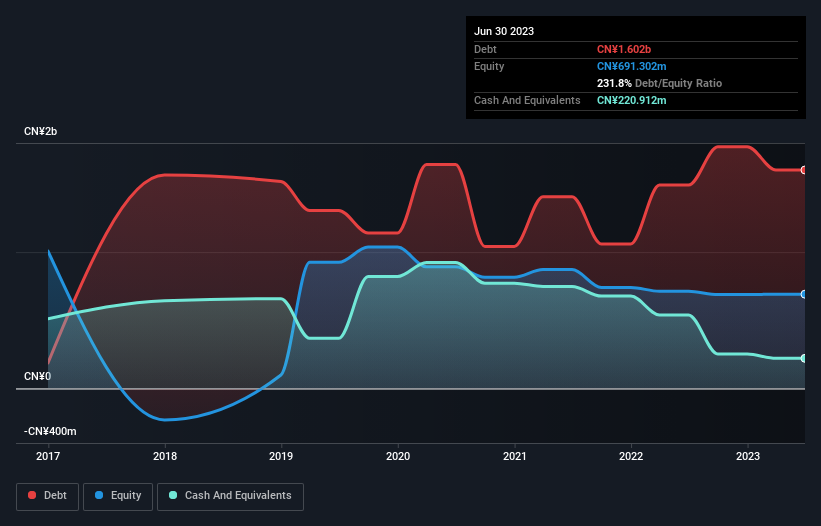- Hong Kong
- /
- Specialty Stores
- /
- SEHK:1817
Does Mulsanne Group Holding (HKG:1817) Have A Healthy Balance Sheet?

The external fund manager backed by Berkshire Hathaway's Charlie Munger, Li Lu, makes no bones about it when he says 'The biggest investment risk is not the volatility of prices, but whether you will suffer a permanent loss of capital.' So it seems the smart money knows that debt - which is usually involved in bankruptcies - is a very important factor, when you assess how risky a company is. We note that Mulsanne Group Holding Limited (HKG:1817) does have debt on its balance sheet. But the more important question is: how much risk is that debt creating?
What Risk Does Debt Bring?
Debt assists a business until the business has trouble paying it off, either with new capital or with free cash flow. Part and parcel of capitalism is the process of 'creative destruction' where failed businesses are mercilessly liquidated by their bankers. However, a more usual (but still expensive) situation is where a company must dilute shareholders at a cheap share price simply to get debt under control. Of course, the upside of debt is that it often represents cheap capital, especially when it replaces dilution in a company with the ability to reinvest at high rates of return. The first thing to do when considering how much debt a business uses is to look at its cash and debt together.
See our latest analysis for Mulsanne Group Holding
What Is Mulsanne Group Holding's Debt?
You can click the graphic below for the historical numbers, but it shows that as of June 2023 Mulsanne Group Holding had CN¥1.60b of debt, an increase on CN¥1.49b, over one year. However, because it has a cash reserve of CN¥220.9m, its net debt is less, at about CN¥1.38b.

A Look At Mulsanne Group Holding's Liabilities
Zooming in on the latest balance sheet data, we can see that Mulsanne Group Holding had liabilities of CN¥1.54b due within 12 months and liabilities of CN¥785.3m due beyond that. Offsetting these obligations, it had cash of CN¥220.9m as well as receivables valued at CN¥431.3m due within 12 months. So its liabilities total CN¥1.68b more than the combination of its cash and short-term receivables.
Given this deficit is actually higher than the company's market capitalization of CN¥1.63b, we think shareholders really should watch Mulsanne Group Holding's debt levels, like a parent watching their child ride a bike for the first time. In the scenario where the company had to clean up its balance sheet quickly, it seems likely shareholders would suffer extensive dilution.
We measure a company's debt load relative to its earnings power by looking at its net debt divided by its earnings before interest, tax, depreciation, and amortization (EBITDA) and by calculating how easily its earnings before interest and tax (EBIT) cover its interest expense (interest cover). The advantage of this approach is that we take into account both the absolute quantum of debt (with net debt to EBITDA) and the actual interest expenses associated with that debt (with its interest cover ratio).
Mulsanne Group Holding shareholders face the double whammy of a high net debt to EBITDA ratio (19.6), and fairly weak interest coverage, since EBIT is just 0.74 times the interest expense. This means we'd consider it to have a heavy debt load. However, the silver lining was that Mulsanne Group Holding achieved a positive EBIT of CN¥14m in the last twelve months, an improvement on the prior year's loss. When analysing debt levels, the balance sheet is the obvious place to start. But you can't view debt in total isolation; since Mulsanne Group Holding will need earnings to service that debt. So if you're keen to discover more about its earnings, it might be worth checking out this graph of its long term earnings trend.
Finally, while the tax-man may adore accounting profits, lenders only accept cold hard cash. So it's worth checking how much of the earnings before interest and tax (EBIT) is backed by free cash flow. Happily for any shareholders, Mulsanne Group Holding actually produced more free cash flow than EBIT over the last year. That sort of strong cash conversion gets us as excited as the crowd when the beat drops at a Daft Punk concert.
Our View
On the face of it, Mulsanne Group Holding's net debt to EBITDA left us tentative about the stock, and its interest cover was no more enticing than the one empty restaurant on the busiest night of the year. But at least it's pretty decent at converting EBIT to free cash flow; that's encouraging. Looking at the balance sheet and taking into account all these factors, we do believe that debt is making Mulsanne Group Holding stock a bit risky. Some people like that sort of risk, but we're mindful of the potential pitfalls, so we'd probably prefer it carry less debt. The balance sheet is clearly the area to focus on when you are analysing debt. However, not all investment risk resides within the balance sheet - far from it. We've identified 2 warning signs with Mulsanne Group Holding , and understanding them should be part of your investment process.
If you're interested in investing in businesses that can grow profits without the burden of debt, then check out this free list of growing businesses that have net cash on the balance sheet.
New: Manage All Your Stock Portfolios in One Place
We've created the ultimate portfolio companion for stock investors, and it's free.
• Connect an unlimited number of Portfolios and see your total in one currency
• Be alerted to new Warning Signs or Risks via email or mobile
• Track the Fair Value of your stocks
Have feedback on this article? Concerned about the content? Get in touch with us directly. Alternatively, email editorial-team (at) simplywallst.com.
This article by Simply Wall St is general in nature. We provide commentary based on historical data and analyst forecasts only using an unbiased methodology and our articles are not intended to be financial advice. It does not constitute a recommendation to buy or sell any stock, and does not take account of your objectives, or your financial situation. We aim to bring you long-term focused analysis driven by fundamental data. Note that our analysis may not factor in the latest price-sensitive company announcements or qualitative material. Simply Wall St has no position in any stocks mentioned.
About SEHK:1817
Mulsanne Group Holding
An investment holding company, engages in the design, marketing, and sale of apparel products for men in Mainland China and Macau.
Slight with imperfect balance sheet.
Market Insights
Community Narratives




